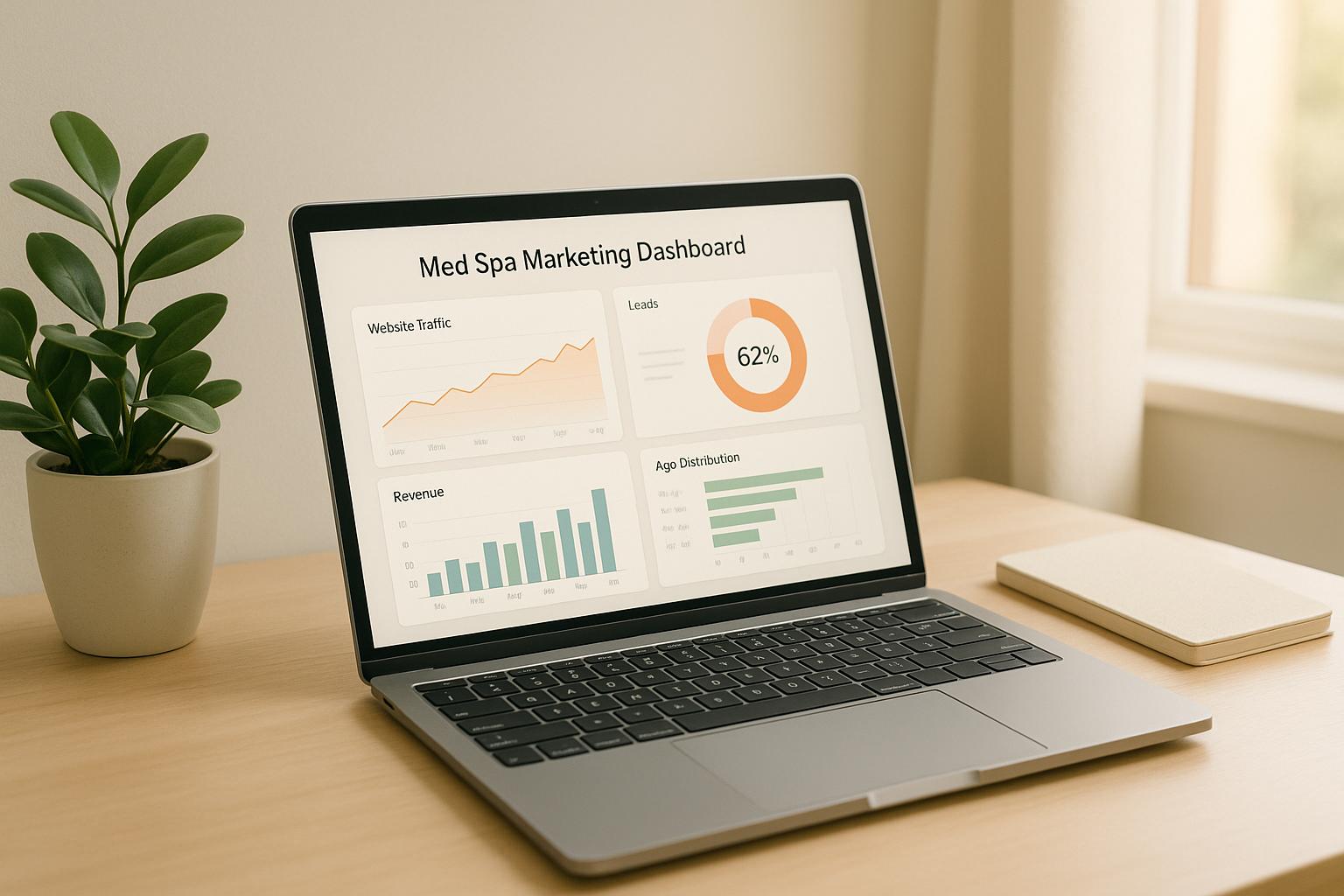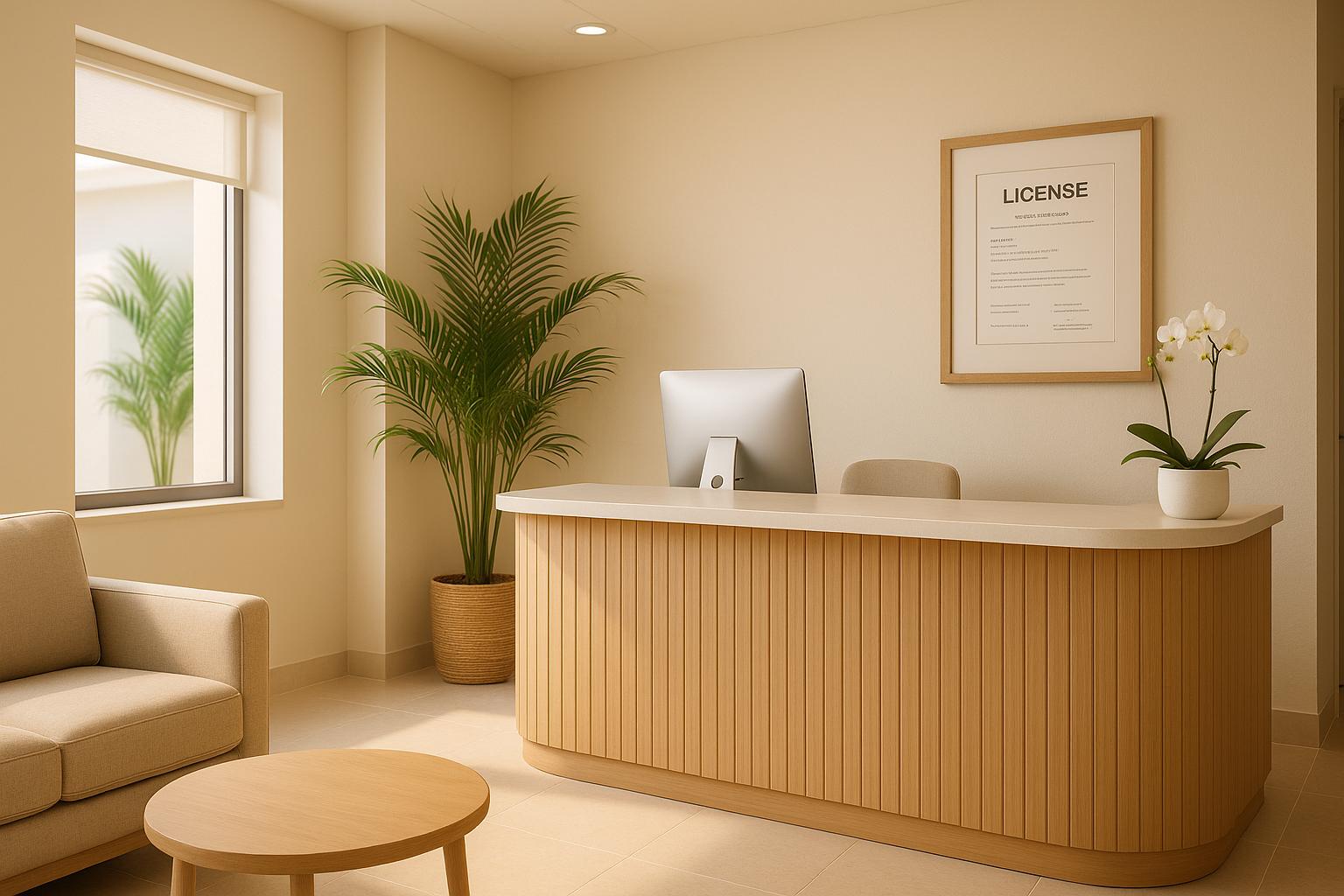Med spas thrive when their employees feel valued, supported, and connected. A positive workplace environment directly affects retention, performance, and client satisfaction. Yet, many med spa owners, often from medical backgrounds, struggle to build this atmosphere, leading to burnout, turnover, and costly recruitment cycles.
Here’s what matters most:
- Employee Recognition: Regular acknowledgment of achievements boosts morale and loyalty.
- Open Communication: Clear expectations and transparency reduce misunderstandings and build trust.
- Work-Life Balance: Flexible schedules and wellness perks prevent burnout and improve satisfaction.
- Professional Growth: Ongoing training and career development keep employees engaged.
- Technology Support: Tools like Prospyr streamline tasks, reduce stress, and enhance efficiency.
The results? Lower turnover, happier employees, better patient care, and higher profitability. Med spas that prioritize these elements consistently outperform competitors and build long-term success.
Research Data: Workplace Culture and Retention Connection
Research highlights a clear link between a supportive workplace culture and improved employee retention in med spas. In an industry where both technical expertise and client care are critical, fostering the right environment can make all the difference.
Cultural Factors That Keep Employees
Certain workplace elements play a big role in keeping employees happy and committed. Things like regular recognition, genuine appreciation, and opportunities for professional growth - such as continuous training - can significantly impact retention.
Flexible scheduling and manageable workloads also help reduce stress, building loyalty among staff. Open communication between management and employees, paired with consistent feedback and clear expectations, fosters a collaborative atmosphere. Additionally, strong team cohesion and positive relationships among peers further strengthen retention efforts.
When these factors are prioritized, they create a foundation for measurable improvements in employee satisfaction and loyalty.
Numbers on Culture and Turnover
The numbers back this up. Med spas with a strong workplace culture report lower turnover rates compared to those with weaker environments. Facilities that actively invest in building a positive culture not only save money on recruitment, training, and lost productivity but also see other benefits. These include higher employee engagement, faster onboarding for new hires, and reduced absenteeism.
This data confirms that focusing on a positive workplace culture isn’t just about keeping employees satisfied - it’s also a smart move for boosting long-term performance and profitability.
Core Elements of Employee-Focused Workplace Culture
Creating a workplace culture that prioritizes employees can make a huge difference in retention and overall satisfaction. By focusing on key elements, businesses can foster an environment where employees feel valued, supported, and motivated to stick around for the long haul.
Recognition and Rewards
Acknowledging achievements regularly can significantly improve retention. When employees see their efforts being noticed, they feel more connected to their workplace. Recognition can take many forms, from formal awards to simple peer-to-peer shoutouts. It’s important to tailor these acknowledgments to individual accomplishments, showing that their unique contributions matter.
Beyond just monetary rewards, offering opportunities for professional growth, flexible time off, wellness perks, or leadership roles in special projects demonstrates a genuine investment in employees' well-being and future. Personalizing these rewards to align with each team member’s preferences adds an extra layer of care, making recognition feel meaningful and sincere.
Open Communication and Transparency
Trust is built on clear and consistent communication. In fact, poor communication between management and staff ranks among the top 10 reasons employees leave their jobs. When employees are kept informed and expectations are clearly laid out, they feel more secure and engaged in their roles.
"Employees rarely leave employers they like and respect." - American Med Spa Association
Conducting stay interviews on a regular basis can help uncover what keeps employees happy and highlight areas that might need attention before problems arise. Transparency in decision-making is equally important. When management explains the reasoning behind schedule changes, policy updates, or other business decisions, employees are more likely to feel included in the journey and supportive of those changes. This open dialogue also creates a foundation for introducing flexible work practices.
Work-Life Balance and Flexibility
For med spas with extended hours and weekend shifts, providing flexible scheduling options can be a game-changer. Whether it’s compressed workweeks, rotating shifts, or remote work for administrative tasks, these adjustments can greatly enhance employee satisfaction. Managing workloads effectively is also crucial to prevent burnout, ensuring team members can maintain their health while delivering high-quality service.
Wellness benefits further demonstrate a commitment to employees’ health. Offering perks like discounted treatments, mental health support, fitness memberships, or stress management resources shows that their well-being is a priority. Additionally, technology can play a big role in supporting work-life balance. Modern practice management tools, like Prospyr, help prevent scheduling conflicts, automate routine tasks, and provide clarity around workloads. These tools make it easier to create a balanced work environment that employees value.
Methods for Building Positive Workplace Culture in Med Spas
Creating a positive workplace culture takes deliberate effort and clear strategies. For med spa owners and managers, implementing thoughtful practices can lead to happier employees, better retention, and a more cohesive team.
Onboarding and Role Clarity
A well-planned onboarding process is the first step to setting employees up for success. It’s not just about teaching new hires their daily tasks - it’s about helping them see how their role fits into the bigger picture of the med spa’s goals, from patient care to business growth. A strong onboarding program should cover essential areas like treatment techniques, legal guidelines, business processes, and technology tools. This ensures employees not only meet compliance standards but also understand how their work contributes to the spa’s profitability and patient satisfaction.
Clear job descriptions and defined performance expectations are equally important. They reduce confusion and help employees feel confident in their roles. Regular check-ins during the first 90 days can address any misunderstandings or concerns early, preventing small issues from escalating into bigger problems. These early efforts lay the groundwork for long-term success and professional growth.
Training and Development Programs
Once onboarding is complete, ongoing training keeps employees engaged and motivated. Regular opportunities to learn and grow build confidence and encourage staff to stay longer. In the fast-evolving world of med spas, staying current with the latest treatments, techniques, and safety protocols is essential - not just for maintaining high service standards but also for boosting employee morale.
Training should be a continuous process, not a one-time event. A structured program that covers everything from treatment-specific skills to legal and business knowledge ensures a well-rounded team. Cross-training employees can also make their workday more varied and interesting, reducing boredom and increasing satisfaction.
Using Technology for Culture-Building
Technology can play a big role in creating a positive work environment. Practice management platforms simplify administrative tasks and improve communication, making day-to-day operations smoother for everyone.
Take Prospyr, for example. Its smart scheduling system helps avoid conflicts and ensures shifts are distributed fairly, which can reduce common workplace tensions. Task management tools make daily responsibilities crystal clear, so nothing important is overlooked.
Real-time analytics can guide managers in balancing workloads, recognizing employee achievements, and providing support where needed. Automated communication tools make sure everyone stays informed, cutting down on miscommunication. Features like digital intake forms and streamlined payment processing free up staff to focus more on patient care. And with AI-powered tools for note-taking and booking, repetitive tasks are minimized, reducing burnout and allowing employees to focus on more rewarding parts of their jobs.
sbb-itb-02f5876
Tracking and Improving Workplace Culture Over Time
Building a positive workplace culture is just the first step. The real challenge lies in tracking its progress and making consistent improvements. Without proper monitoring, med spa owners may find it hard to determine whether their efforts are genuinely effective or just creating extra tasks.
Using Data to Track Culture
Once a positive culture is in place, the next step is measuring its impact and refining it over time. Employee satisfaction surveys are one of the most straightforward ways to gather insights. Conduct these surveys quarterly or monthly, focusing on areas like communication, recognition, work-life balance, and career development. To encourage honest feedback, keep the surveys anonymous so employees feel safe sharing their thoughts.
Turnover analytics provide another layer of insight. By tracking overall turnover rates and identifying departments with higher turnover, you can spot potential issues. Pay attention to how long new hires stay and whether there are specific times when departures spike. Exit interviews can help uncover whether employees are leaving due to cultural issues, limited growth opportunities, or management challenges.
Engagement metrics are also valuable for evaluating workplace culture. Look at factors like attendance rates, participation in company events, internal promotions, and how quickly employees respond to internal communications. High engagement levels often signal a healthy workplace culture, while declining participation may indicate emerging problems.
Finally, performance indicators can reveal the broader effects of workplace culture. Teams with strong cultures often achieve higher patient satisfaction scores, better treatment results, and fewer compliance issues. By monitoring these alongside traditional HR metrics, you can get a more complete picture of how culture impacts your business.
A data-driven approach like this makes it easier to identify areas for improvement and ensure your workplace culture evolves effectively.
Maintaining Long-Term Improvements
Creating a positive culture isn’t a one-time task; it requires consistent effort. Schedule quarterly evaluations that combine survey results, turnover data, and performance metrics to identify what’s working and what needs adjustment. This proactive approach helps prevent small issues from becoming bigger problems.
Flexibility based on feedback is crucial for long-term success. For example, if surveys show that recognition programs aren’t resonating with employees, try alternative methods. Maybe public praise isn’t effective, but offering professional development opportunities could be more meaningful to your team. The ability to adapt based on feedback is what separates successful culture initiatives from those that fall flat.
Leadership accountability plays a big role in sustaining improvements. Assign managers the responsibility of tracking culture metrics and include these in their performance reviews. When leadership advancement depends partly on team satisfaction and retention rates, workplace culture becomes a priority for everyone, not just the HR department.
Technology updates should also align with your culture goals. As your team grows and changes, the tools you use to support a positive workplace culture may need to evolve. Regularly assess whether your current technology is helping or hindering your efforts, and make adjustments as needed.
The most successful med spas treat workplace culture like any other essential business metric. With consistent measurement, clear goals, and regular adjustments, you can turn workplace culture into a measurable factor that drives employee retention and overall business success.
Conclusion: The Long-Term Benefits of Strong Workplace Culture
Studies consistently show that a positive workplace culture plays a key role in improving med spa employee retention. When med spa owners focus on creating supportive and engaging work environments, they set the stage for sustainable business growth and reap a wide range of benefits.
A thriving workplace culture has a ripple effect across the entire business. Employees who feel appreciated tend to deliver better care and work more efficiently, which directly impacts treatment results. There’s also a financial upside - replacing skilled staff can be expensive when you factor in recruitment, training, and the productivity lost during the transition.
Med spas that actively work on building a strong culture often experience lower turnover rates and better patient outcomes. With fewer employees leaving, hiring costs drop, and patient relationships become more consistent. High employee engagement also leads to better attendance and greater participation in professional development programs. Together, these elements create a competitive edge that’s hard to match. This efficiency also paves the way for integrating tools like practice management platforms to further enhance the workplace environment.
Platforms such as Prospyr, for example, simplify administrative tasks, which can significantly reduce workplace stress. By automating routine operations, these tools allow staff to dedicate more time to patient care, naturally increasing job satisfaction and overall morale.
Savvy med spa owners understand that investing in workplace culture leads to long-term rewards. This approach aligns with proven strategies like recognition programs, continuous professional development, and effective communication. These efforts not only reduce turnover costs but also improve patient satisfaction and overall business performance. By regularly assessing and fine-tuning their strategies, these businesses create lasting competitive advantages that benefit employees, patients, and the organization as a whole.
Ultimately, building a strong workplace culture isn’t just about keeping employees content - it’s about fostering an environment where both staff and patients can thrive, ensuring long-term success for everyone involved.
FAQs
What are some effective ways med spa owners can create a culture of recognition and rewards to boost employee retention?
Creating a workplace where recognition and rewards thrive in a med spa begins with personalized acknowledgment. A simple shoutout during a team meeting or highlighting an employee's success on social media can go a long way. These small yet meaningful gestures create a sense of value and connection within the team.
Adding wellness-focused rewards into the mix can take employee satisfaction to another level. Think spa treatments, flexible work hours, or wellness stipends - benefits that resonate with the industry and show you care about their well-being. On top of that, offering chances for professional growth, like training sessions or certifications, shows your team you’re invested in their future. This approach not only builds loyalty but also helps keep turnover low.
When med spa owners make it a habit to recognize efforts and tailor rewards to fit both personal and professional needs, they create a supportive and positive environment where employees are more likely to stick around and thrive.
How can med spas promote open communication and transparency with their staff?
Med spas can build trust and openness by establishing clear policies and keeping their staff informed about the business’s goals and any important updates. Regular team meetings are a great way to encourage participation, allowing employees to share their ideas, concerns, and feedback.
It’s equally important to create a workplace where staff feel safe expressing concerns without fear of criticism. Offering regular feedback and acknowledging the efforts of employees can go a long way in fostering a sense of trust and mutual respect among the team.
How can tools like Prospyr improve work-life balance and workplace culture in med spas?
Technology solutions like Prospyr are transforming the way med spas operate by taking over tedious tasks like scheduling, payment processing, and patient communication. By automating these time-consuming responsibilities, staff can dedicate more energy to what truly matters: providing excellent care and building meaningful connections with clients.
On top of that, tools such as AI-powered features, marketing automation, and practice analytics simplify workflows and reduce stress. This not only makes daily operations smoother but also contributes to a more supportive and uplifting work environment. The result? Happier employees, stronger team morale, and improved staff retention.



